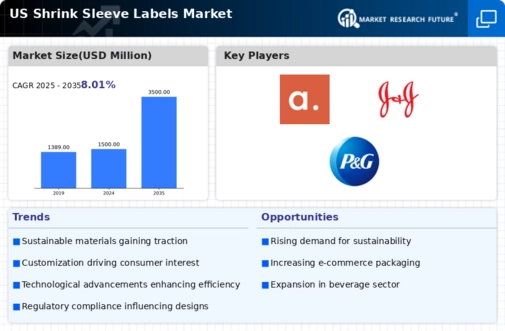Growth in the Beverage Sector
The beverage industry is a significant driver of the shrink sleeve-labels market, contributing substantially to its expansion. With the increasing consumption of packaged beverages, the demand for effective labeling solutions has surged. In 2025, the beverage sector is expected to represent around 40% of the shrink sleeve-labels market. This growth is attributed to the need for eye-catching designs that attract consumers and convey essential product information. Additionally, the rise of craft beverages and innovative packaging formats has further fueled the demand for shrink sleeve labels, as brands strive to stand out on crowded shelves. Consequently, the shrink sleeve-labels market is poised to thrive alongside the evolving beverage landscape.
Rising Demand for Customization
The shrink sleeve-labels market is experiencing a notable increase in demand for customized labeling solutions. This trend is driven by the need for brands to differentiate their products in a competitive landscape. Customization allows companies to create unique designs that resonate with consumers, enhancing brand recognition. In 2025, the market for customized labels is projected to account for approximately 35% of the total shrink sleeve-labels market. This shift towards personalization is particularly evident in sectors such as food and beverage, where packaging aesthetics play a crucial role in consumer choice. As brands seek to establish a distinct identity, the shrink sleeve-labels market is likely to benefit from this growing inclination towards tailored solutions.
Technological Innovations in Printing
Technological advancements in printing techniques are significantly influencing the shrink sleeve-labels market. Innovations such as digital printing and flexographic printing have enhanced the quality and efficiency of label production. In 2025, it is anticipated that these technologies will account for nearly 30% of the shrink sleeve-labels market. The ability to produce high-quality, vibrant labels at lower costs has made shrink sleeve-labels more accessible to a wider range of businesses. Furthermore, advancements in printing technology allow for shorter production runs, catering to the growing demand for customized and limited-edition products. As a result, the shrink sleeve-labels market is likely to benefit from these technological innovations.
Regulatory Compliance and Safety Standards
Regulatory compliance plays a pivotal role in shaping the shrink sleeve-labels market. As industries face increasing scrutiny regarding labeling accuracy and safety standards, the demand for compliant labeling solutions has intensified. In 2025, it is estimated that approximately 25% of the shrink sleeve-labels market will be driven by the need for labels that meet stringent regulations. This is particularly relevant in sectors such as pharmaceuticals and food, where accurate labeling is critical for consumer safety. Companies are increasingly investing in shrink sleeve-labels that not only comply with regulations but also enhance product traceability. Thus, the emphasis on regulatory compliance is likely to propel growth in the shrink sleeve-labels market.
Expansion of Retail and E-commerce Channels
The expansion of retail and e-commerce channels is a crucial driver of the shrink sleeve labels market. As online shopping continues to gain traction, brands are increasingly focusing on packaging that enhances the unboxing experience. In 2025, it is projected that e-commerce will account for approximately 20% of the shrink sleeve-labels market. This shift necessitates labels that are not only visually appealing but also durable enough to withstand shipping and handling. Additionally, the rise of subscription services and direct-to-consumer models has created a demand for innovative packaging solutions. Consequently, the growth of retail and e-commerce channels is expected to significantly impact the shrink sleeve-labels market.














Leave a Comment